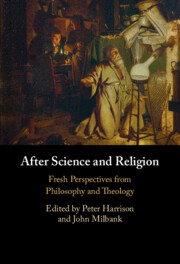Book contents
- After Science and Religion
- Reviews
- After Science and Religion
- Copyright page
- Contents
- Contributors
- Acknowledgements
- Introduction
- Part I Modern Historians on ‘Science’ and ‘Religion’
- Part II Beyond ‘Science and Religion’
- Part III Philosophical Problems with ‘Science’ and ‘Religion’
- Part IV Before Science and Religion
- Chapter 11 Lessons in the Distant Mirror of Medieval Physics
- Chapter 12 Physics as Spiritual Exercise
- Chapter 13 Making Art
- Conclusion
- References
- Index
Conclusion
from Part IV - Before Science and Religion
Published online by Cambridge University Press: 05 May 2022
- After Science and Religion
- Reviews
- After Science and Religion
- Copyright page
- Contents
- Contributors
- Acknowledgements
- Introduction
- Part I Modern Historians on ‘Science’ and ‘Religion’
- Part II Beyond ‘Science and Religion’
- Part III Philosophical Problems with ‘Science’ and ‘Religion’
- Part IV Before Science and Religion
- Chapter 11 Lessons in the Distant Mirror of Medieval Physics
- Chapter 12 Physics as Spiritual Exercise
- Chapter 13 Making Art
- Conclusion
- References
- Index
Summary
This chapter uses historic examples – the Enlightenment origins of modern computing and the methods of medieval painters – to juxtapose the modern and pre-modern everyday experiences of work. It acknowledges that the official (albeit impracticable) disqualification of human intuition, aesthetics and proprioception in the pursuit of modern science has been responsible for significant technical advances. However, it also recognises that exactly the same disqualification also limits the modern scientific worldview, excluding much of what it means to be human. That impact is not restricted to specialist behaviours in the scientific laboratory but also has impoverishing consequences for those who interact with the scientific laboratory’s everyday technological products. It suggests that moving beyond the territorial disputes of ‘science and religion’ will require re-engagement of the whole human in the structured pursuit of material knowledge, methodologically complicating post-modern science but simultaneously enriching post-modern everyday lived experience.
- Type
- Chapter
- Information
- After Science and ReligionFresh Perspectives from Philosophy and Theology, pp. 316 - 324Publisher: Cambridge University PressPrint publication year: 2022
- 2
- Cited by

